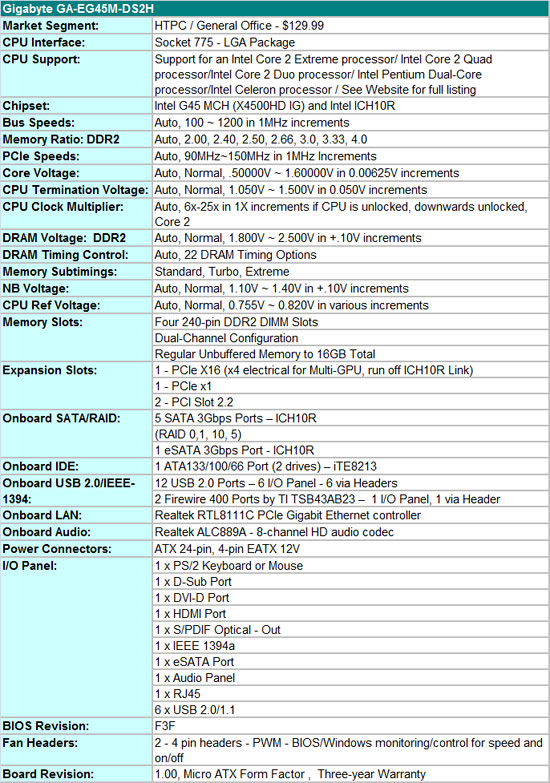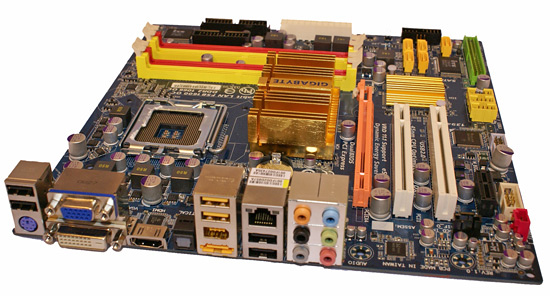The IGP Chronicles Part 1: Intel's G45 & Motherboard Roundup
by Anand Lal Shimpi & Gary Key on September 24, 2008 12:00 PM EST- Posted in
- Motherboards
Gigabyte GA-EG45M-DS2H
Our second board is the Gigabyte GA-EG45M-DS2H and it has an interesting secret hiding underneath an otherwise excellent set of features and BIOS options. In fact, from a layout and component overview, this was initially our favorite board after opening our retail boxes. Why did we change our minds, well Gigabyte decided to take an opposite turn when it came to deciding on the discreet graphics capability for this board. Sometimes, taking a left when everyone goes right is good, but we think Gigabyte missed a great opportunity with this board.

You see, the x16 graphics slot is not run off the MCH that would have provided a true x16 PCIe 2.0 capable slot. Instead, Gigabyte placed an x16 connector on the board that actually runs off the ICH10R at x4 PCIe 1.1 speeds. Not only is this slot bandwidth limited, it must also negotiate with the MCH via the DMI link that further slows progress. This is not bad for simple 2D graphics or even Vista’s Aero interface, but that is the limit. Why did Gigabyte make this decision? They thought the market for true multi-display output via an IG solution that retains its strengths (accelerated BD playback, HDMI audio) was greater than the SFF performance/enthusiast sector.
Gigabyte might very well be right, but we think that market would be more inclined to utilize the G43 or G33 chipsets in a business environment where accelerated BD playback is probably no more warranted than the number of enthusiasts looking to build a SFF performance system. Unfortunately, with the G45 chipset you cannot have both, as the digital output is muxed across the x16 lane in the MCH, which prohibits the use of the X4500HD and a discrete GPU at the same time unless you run the dGPU off the Southbridge.
Otherwise, the BIOS options and feature set of this board matches that of the ASUS and in some ways is better in our estimation. The BIOS offers a dizzying array of options for the enthusiast or for those just wanting to undervolt their system in order to save energy costs. Gigabyte continues with their Crtl-F1 policy for accessing the advanced options in the BIOS. The GA-EG45M-DS2H features Realtek RTL8111C PCIe Gigabit Ethernet, Firewire 400 support from a TI chipset, PATA support via the iTE8213 (noticed a pattern yet that JMicron is out, so we rejoice), HD audio from the now standard ALC889a codec featuring DTS Live and Dolby Home Theater capabilities, and RAID from the ICH10R. Of note, the latest version of Gigabyte's DES power saving technology actually performed slightly better on this board than the ASUS EPU-4 engine on the P5Q-EM. Overall, Gigabyte built a high quality and full featured uATX board that should satisfy just about any HTPC or SOHO user.

Gigabyte provided a very good layout if one considers that a discrete graphics card will probably never be used in this board. If so, we found it difficult to change the memory with a full-length video card in the slot. Our only other problem is that low profile CPU fan/heatsinks like the Arctic Cooling Freezer 7 LP will not work due to the height of the MCH heantsink. Otherwise, we did not have any further problems when installing a variety of peripherals. The MCH and ICH heatsinks provided adequate cooling in our Thermaltake case during 24/7 operation.
Gigabyte also utilizes an excellent four-phase power delivery system along with very good solid capacitors throughout the board that resulted in superb stability throughout our four hundred hour testing regimen. We utilized the latest F3F BIOS that features several improvements including enhanced 8GB compatibility along with memory performance enhancements, additional processor support (EO steppings), and improved overclocking support with lower end processors like the E5200. Support from Gigabyte has been very good on this product.
We were able to reach the 407~412FSB range when overclocking with the X4500HD active. This matches the ASUS board and seems to be the level where stability is still possible when utilizing the IG core. We were able to go higher, but started running into application problems, mainly games like Age of Conan and BD playback. Neither of which we would normally utilize with an overclocked system. In fact, we tend to want to underclock and undervolt our home theater systems during playback sessions. As far as the performance penalty incurred for running a card like the AMD 4850 or NVIDIA 8800GT off the Southbridge, it tends to be around 15~22%. We are running tests with the AMD 4670/NV 9600GT cards and will report additional results in our final article.
We would like to commend Gigabyte for their new labeling design on the various USB, Firewire, and other connectors on the motherboard. It would not be a typical article without us commenting on the crayola color scheme but we have come to accept it as Gigabyte’s trademark. However, the last time we checked, colors did not make or break a board’s stability or performance. That said, keeping things cool when running a 24/7 media center is important and the fact that this board only had two fan headers is a bit puzzling. The fan control and monitoring via the BIOS or Windows is very good, we just expected another fan header to be included. S1 and S3 resume support worked correctly with a variety of components and BIOS selections.
Pros/Cons
Overall, we have a board that confuses us (yes, shiny trinkets do the same but bear with us on this one). The design, component selection, BIOS options, and general performance scream of a board that is just waiting to go into a performance oriented SFF system. We were hyped about comparing the ASUS and Gigabyte boards against each other in a future SFF guide. After reading the specifications and then contacting Gigabyte to be make sure the technical document group did not screw up, we had a supreme let down.
However, this chipset is targeted to the multimedia and SOHO crowd and as such, we cannot fault Gigabyte too much for their decision, as unpopular as it seems. On the plus side, Gigabyte did include an eSATA port on the IO panel and if you must use onboard audio, they have the best solution in this roundup. If we were to improve the board, our first item would be a true x16 PCIe slot for graphics, then a different MCH heatsink design, and finally at least one more fan header. If you need a feature rich and high quality motherboard for HTPC or SOHO duties only, then the Gigabyte FA-EG45M-DS2H is an excellent choice.
















53 Comments
View All Comments
sprockkets - Wednesday, September 24, 2008 - link
Except the fact that you needed a firmware update on the home theater receiver is just bulls****.Thanks DRM!
I can't wait till VLC gets native blue ray support! At least we have Sly-Soft!
DoucheVader - Friday, September 26, 2008 - link
Hey if it wasn't for a vast majority of people copying stuff, we wouldn't have DRM. I am sick of the complaints. We as consumers created this problem.Most things that have DRM are to protect someone's bread and butter. How would you like it if every time you got paid there was some money missing?
- Saturday, September 27, 2008 - link
Your point might be valid if DRM worked, but can you point out a single mainstream home theater medium on which the DRM means anything to the pirates?DRMed CDs? Ha. Those just pissed off consumers when they inevitable didn't play in some players and/or contained bad software. Often defeated with the frickin shift key.
DVD? People have tattoos of the DeCSS source code it's that damn short. Amusingly the longest lasting DRM scheme, with 2.5 years between the first DVD movie release and the release of DeCSS.
HD-DVD? 253 days, not even a full year after the format first shipped its AACS protection system was cracked. Under three weeks later the first copies start showing up on private trackers.
Blu-Ray (AACS)? The same AACS crack applied to it, and about two weeks after the first HD-DVD copies showed up Blu-Ray was right behind it. Launch to first pirated movie: 225 days.
Blu-Ray (BD+)? Slightly harder than AACS apparently, but titles did not ship with it until October 2007 so the cracking community got off to a late start. AnyDVD HD supported decrypting all BD+ titles roughly 5 months after the first titles shipped and copies again showed up soon after.
I'm less familiar with DVD-Audio and SACD, but my understanding is that there hasn't been a direct "crack" of their respective encryption but instead PC-based players and/or sound drivers are modified to just write the decoded bitstream to the hard drive. This works quite well for audio, as in most cases the compression (if any) applied on the disc is not wanted and the uncompressed PCM stream is exactly what the user desires. For obvious reasons that is not feasible with video.
Once these protections are broken, they do nothing to reduce piracy and only remain to prevent fair-use backups by technologically illiterate users and/or to annoy consumers with crap like these HDCP issues.
It doesn't even matter to the pirate crowd whether the cracks are public or private, as long as someone can do it that means the files will get out, and once they're out they're out.